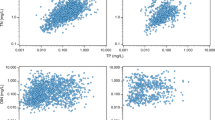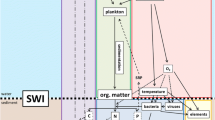Abstract
Lake Baikal, Russian Siberia, was sampled in July 1990 during the period of spring mixing and initiation of thermal stratification. Vertical profiles of temperature, dissolved nutrients (nitrate and soluble reactive phosphorus), phytoplankton biomass, and primary productivity were determined in an eleven-station transect encompassing the entire 636 km length of the lake. Pronounced horizontal variability in hydrodynamic conditions was observed, with the southern region of the lake being strongly thermally stratified while the middle and north basins were largely isothermal through July. The extent of depletion of surface water nutrients, and the magnitude of phytoplankton biomass and productivity, were found to be strongly correlated with the degree of thermal stratification. Horizontal differences likely reflected the contribution of two important factors: variation in the timing of ice-out in different parts of the lake (driving large-scale patterns of thermal stratification and other limnological properties) and localized effects of river inflows that may contribute to the preliminary stabilization of the water column in the face of intense turbulent spring mixing (driving meso-scale patterns). Examination of the relationships between surface water inorganic N and P depletion suggested that during the spring and early summer, phytoplankton growth in unstratified portions of the lake was largely unconstrained by nutrient supplies. As summer progressed, the importance of co-limitation by both N and P became more apparent. Uptake and regeneration rates, measured directly using the stable isotope 15N, revealed that phytoplankton in stratified portions of the lake relied primarily on NH4 as their N source. Rates of NH4 regeneration were in approximate equilibrium with uptake; both processes were dominated by organisms <2 µm. This pattern is similar to that observed for oligotrophic marine systems. Our study underscores the importance of hydrodynamic conditions in influencing patterns of biological productivity and nutrient dynamics that occur in Lake Baikal during its brief growing season.
Similar content being viewed by others
References
Abbott, M. R., T. M. Powell & P. J. Richerson, 1982. The relationship of environmental variability to the spatial patterns of phytoplankton in Lake Tahoe. J. Plankton Res. 4: 927–941.
American Public Health Association, 1976. Standard methods for the examination of water and wastewater. Washington, D.C. 1973 pp.
Denman, K. L. & T. M. Powell, 1984. Effects of physical processes on planktonic ecosystems in the coastal ocean. Oceanogr. Mar. Biol. Ann. Rev. 22.
Dugdale, R. & F. Wilkerson, The use of 15N to measure nitrogen uptake in eutrophic oceans: experimental considerations. Limnol. Oceanogr. 31: 673–689.
Dugdale, R. & F. Wilkerson, 1992. Nutrient limitation and new production in the sea. In: P. G. Falkowski & A. D. Woodhead (eds), Primary Productivity and Biogeochemical Cycles in the Sea. Plenum Press, New York. 550 pp.
Fleiss, J. L., 1981. Statistical methods for rates and proportions. 2nd edition. John Wiley and Sons, New York. 321 pp.
Galazy, G. I., 1984. Lake Baikal and its protection. Verh. Int. Ver. Limnol. 22: 1137–1141.
Glibert, P. M., F. Lipshultz, J. J. McCarthy & M. A. Altabet, 1982. Isotope dilution models of uptake and remineralization of ammonium by marine plankton. Limnol. Oceanogr. 27: 639–650.
Goldman, C. R., 1963. The measurement of primary productivity and limiting factors in freshwater with C-14, In M. S. Doty (ed.), Proceedings of the Conference on Primary Productivity Measurement, Marine and Freshwater. U.S. Atomic Energy Commission, TID-7633: 103–113.
Goldman, C. R. & A. Jassby, 1990. Spring mixing depth as a determinant of annual primary production in lakes, In M. M. Tilzer & C. Serruya (eds), Large Lakes: Ecological Structure and Function. Springer-Verlag, NY: 125–132.
Golubev, V. A., J. Klerkx & R. Kipfer, 1993. Heat flow, hydrothermal vents and static stability of discharging thermal water in Lake Baikal (south-eastern Siberia). Bull. Centres Rech. Explor.-Prod. Elf Aquitaine 17: 53–65.
Harris, G. P., 1986. Phytoplankton ecology: structure, function, and fluctuation. Chapman and Hall.
Kamaltynov, R. M., 1993. On the present state of amphipod systematics. Hydrobiol. J. 26: 82–92.
Kamphake, L. J., S. A. Hannaht & J. M. Cohen, 1967. Automated analysis for nitrate by hydrazine reduction. Water Res. 1: 205–216.
Laws, E., 1984. Isotope dilution models and the mystery of the vanishing 15N. Limnol. Oceanogr. 29: 379–396.
Martin, P., 1994. Speciation in Ancient Lakes (ed.), K. Martens, B. Goddeeris & G. Coultrer. Stuttgart, December 1994, Arch. Hydrobiol. Beih. Ergebn. Limnol. 44: 3–11.
Moskalenko, P. K. & K. K. Votintsev, 1972. p. 207–226. In Z. Kajak & A. Hillbricht-Ilkowska (eds), Productivity Problems of Freshwaters. PWM-Polish Scientific Publ.
Priscu, J. C., 1989. Photon dependence of inorganic nitrogen transport by phytoplankton in perennially ice-covered Antarctic lakes. Hydrobiologia 172: 173–182.
Priscu, J. C., W. F. Vincent & C. Howard-Williams, 1989. Inorganic nitrogen uptake and regeneration in perennially ice-covered lakes Fryxell and Vanda, Antarctica. J. Plankton Res. 11: 335–351.
Priscu, J. C., M. P. Lizotte, G. F. Cota, A. C. Palmisano & C. W. Sullivan, 1991. Comparison of the irradiance response of photosynthesis and nitrogen uptake by sea ice microalgae. Mar. Ecol. Progr. Ser. 70: 201–210.
Redfield, A. C., 1958. The biological control of chemical factors in the environment. Am. Sci. 46: 205–221.
Reynolds, C. S., 1984. The Ecology of Freshwater Phytoplankton. Cambridge University Press.
Richards, F. A., 1981. Coastal Upwelling. American Geophysical Union.
Roberts, D. G. & D. M. Smith, 1988. Infrared gas analysis of both gaseous and dissolved CO2 in small volume marine samples. Limnol. Oceanogr. 33: 135–140.
Robinson, J. A., 1985. Determining microbial kinetic parameters using nonlinear regression analysis: advantages and limitations in microbial ecology. In K. C. Marshal (ed.), Advances in Microbial Ecology. Plenum Press, New York: 61–114.
Sinyukovich, V. N. & L. M. Sorokovikova, 1991. Selenga River — Lake Baikal. Mimeographed publication of the Limnological Institute of Siberian Div. of USSR Acad. Sci., Irkutsk, USSR. 3 P.
Smith, W. O. & D. M. Nelson, 1985. Phytoplankton bloom produced by a receding ice edge in the Ross Sea: spatial coherence with the density field. Science 227: 163–166.
Solorzano, L., 1969. Determination of ammonia in natural waters by the phenolhypochlorite method. Limnol. Oceanogr. 14: 799–801.
Sverdrup, H. U., 1953. On the conditions for the vernal blooming of phytoplankton. J. Cons. Int. Explor. Mer. 18: 287–295.
Timoshkin, O. A., 1994. Free-living Plathyhelminthes — a model group for the evolution of invertebrates in Lake Baikal. Speciation in Ancient Lakes, K. Martens, B. Goddeeris & G. Coultrer (eds), Stuttgart, December 1994. Arch. Hydrobiol. Beih. Ergebn. Limnol. 44: 183–196.
Timperly, M. H. & J. C. Priscu., 1986. Determination of nitrogen-15 by optical emission spectrometry using an atomic absorption spectrometer. Analyst 111: 23–28.
Votintsev, K. K., 1986. Evolution of the water quality of Lake Baikal. Hydrobiol. J. 22: 1–6.
Weiss, R. F., E. C. Carmack & V. M. Koropalov, 1991. Deep-water renewal and biological production in Lake Baikal. Nature 349: 665–669.
Author information
Authors and Affiliations
Rights and permissions
About this article
Cite this article
Goldman, C.R., Elser, J.J., Richards, R.C. et al. Thermal stratification, nutrient dynamics, and phytoplankton productivity during the onset of spring phytoplankton growth in Lake Baikal, Russia. Hydrobiologia 331, 9–24 (1996). https://doi.org/10.1007/BF00025403
Received:
Revised:
Accepted:
Issue Date:
DOI: https://doi.org/10.1007/BF00025403




